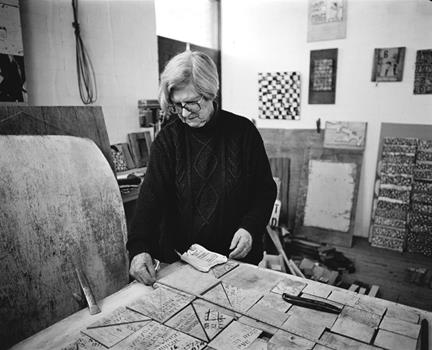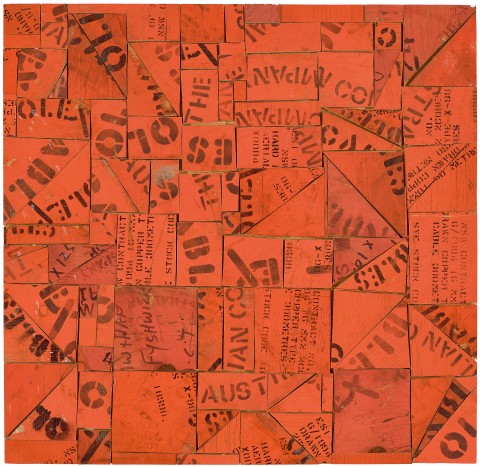TARTAN, 1998
ROSALIE GASCOIGNE
sawn, painted and stencilled wood from cable reels on board
91.0 x 93.0 cm
signed, dated and inscribed with title verso: Rosalie Gascoigne / 1998 / TARTAN
Roslyn Oxley9 Gallery, Sydney (label attached verso)
Private collection, Queensland, acquired from the above in 1999
Rosalie Gascoigne, Roslyn Oxley9 Gallery, Sydney, 1 – 25 September 1999, cat. 13 (illus. on exhibition invitation)
Rosalie Gascoigne, The Ian Potter Centre, National Gallery of Victoria, Melbourne, 19 December 2008 – 15 March 2009, cat. 77
Gellatly, K. (with Clark, D. and Gascoigne, M.), Rosalie Gascoigne, National Gallery of Victoria, Melbourne, 2009, pp. 113 (illus.), 136
Gascoigne, M., Rosalie Gascoigne. A Catalogue Raisonné, ANU Press, Canberra, 2019, cat. 667, pp. 305 (illus.), 347, 353, 418
210574.jpg

Rosalie Gascoigne, one of the most important Australian artists of the 20th century, achieved late in life accolades that no woman artist before her ever had. Her humble and frugal art was deeply informed by the geographic features of her adopted Australian homeland and followed a progression of formal and abstract distillation, moving gradually from sculptural maquettes to bold and graphic planar assemblages. Her late assemblages on board varied in format from minute colour and textural studies to massive road sign and Schweppes-crate metaphorical landscapes. These works were all anchored in their emphasis on the aesthetic qualities of her found materials and its poetic associative power. The origin and function of her found objects (transport crates, cable reels, road signs, wood, china and linoleum) was often completely obscured by the artist’s process of fragmentation and reconstitution. Instead of making the material qualities the subject of her artistic intervention, it was the palimpsestic traces on their surfaces that fascinated the artist: traces of the life it has lived in the harsh Australian landscape: bleaching, warping, bruising and cracking.
In 1998, Rosalie Gascoigne was aged 85 and despite having spent the majority of her life as an expatriate, found herself reflective on her early childhood in New Zealand, incorporating flashbacks to old experiences and places into her artworks.1 While all of Gascoigne’s works had a certain site-specific autobiographical quality, the rhythmic and noisy bricolage, Tartan, 1998, reveals in its title a cultural metonymy that linked the artist with her own ancestral roots. This work is a studio work, an intellectual puzzle on a modest scale. Using, with an astounding economy, nothing but the tonal contrast between black stencilled text and its weathered painted hardwood support, Gascoigne evokes the crisscross woven patterns of tartan fabric. Tartan is the symbolic national dress of Scotland and was used here as expression of the artist’s own origins, well-to-do Anglo-Scottish and Irish protestant, and more broadly an interrogation of colonial legacy of the English empire on the far-flung lands of Oceania where she resided.
William C Seitz likened the assemblage artist to a modern-day poet and this rings especially true for Rosalie Gascoigne, whose works were a product of the co-existence of natural and cultural processes. Arranged around the structural principle of the grid (her most Modern artistic device2), small sections of hardwood, tesserae, are cut into carefully proportioned crisp squares and equilateral triangles. Their rigorous arrangement into vertical and horizonal dominant lines emphasizes the dissonant curved printing of the text, this tension creating a dynamic quality within the square picture plane. The restriction of Gascoigne’s palette to materials that she had gathered during her rambles through the plains of the Monaro region necessarily created series of works with repeated visual strategies and materials. The titles were then added after completion and according to Mary Eagle, were ‘neither bound to, nor reflected the process of construction’.3
In 1993, some 5 years prior to the construction of Tartan, Gascoigne chanced upon some wooden cable spools, used to transport telephone powerlines and fencing wire. These large hardwood reels had several aesthetic attractions for her: curved rims painted in vibrant colours (red, yellow, orange, white and black) and were often stencilled, stamped and inscribed with letters and numbers, and punctured with uniform holes. While at first she prioritized the use of the “grubby white spools” between 1993 – 1994, Gascoigne moved quickly on to the ones for copper wire, painted red. Many of the works created with this wood used colour associations for their titles: Shabby Summer, 1994- 5, The Apple Isle 1994 – 95, Wild Strawberries, 1995, Embers I and II, 1998, Rose Hips, 1998, Ruby Rose, 1998, Western Plains, 1998, Carnival, 1998 and Fiesta, 1999.4
Tartan was included in Gascoigne’s last solo exhibition at Roslyn Oxley9 Gallery in Sydney, by which point the artist was too ill to travel to see and passed away a month later. Alongside Tartan were intimate works focused on textural minutiae, and her last major masterpieces: Metropolis and Great Blond Paddocks, both of which were acquired by the Art Gallery of New South Wales that year. Tartan was also chosen to be included in the last major retrospective exhibition to be held in Australia of Rosalie Gascoigne’s work, at The Ian Potter Centre: NGV Australia in Melbourne, in 2008–09.
1. O’Brien, G., ‘Plain Air/Plain Song’ in Rosalie Gascoigne, Plain Air, City Gallery Wellington, Victoria University Press, 2004, p. 47
2. Edwards, D., Rosalie Gascoigne. Material as Landscape, Art Gallery of New South Wales, Sydney, 1998, p. 13
3. Eagle, M., ‘Rosalie Gascoigne’, From the Southern Cross: A view of world art, c.1940 – 1988, Biennale of Sydney, 1988, p. 132
4. Gascoigne, M., Rosalie Gascoigne: A Catalogue Raisonné, ANU Press, Canberra, 2019, pp. 76, 125
LUCIE REEVES-SMITH
